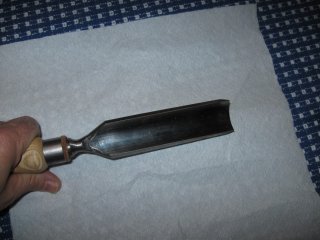
Last Fall my wife was at the church rummage sale and found this.
That is a big ol' wood carver's gouge. It is a 32mm (1 1/4") gouge made by Robert Sorby, as you can see on the handle.
This tool was designed for heavy use with a mallet, which you can tell from the steel reinforcing ring on the tail of the handle (to keep the wood from splitting when you hit it) and the shock absorbing leather washer in the ferrule. It looks like I might be able to use this for carving out the heel of my next banjo neck.
The gouge is brand new and has never been used. This is obvious because the edge has never been honed. You can still see the machine marks on the bevel.
In fact, the tool is so dull you can see the edge of it if you hold it up to the light just right.
That bright line along the top is a flat place where the edge is supposed to go.
This is a serious carving tool and not at all like my piddly little X-Acto® gouge that I have used in the past. Here is a photo of that other gouge.
I have a friend who is a professional wood carver, and I asked him about my new gouge. He told me that the bevel is left rough so that the carver can adjust the way it is honed to his own preference without having to undo a honing done by the manufacturer. He also told me how to sharpen this curved tool on my flat stones.
The trick with honing the gouge is to pull the edge along the length of the stone while rolling it over the round bevel. So I started holding the tool like this:
with the blade at the far end of the stone, and then I pulled it toward me across the length of the stone while rotating the blade. I ended up with the blade like this:
Then I put the blade back at the other end of the stone and did it again. That is my left hand in the photo. I had my right hand on the handle of the gouge to steady it at the proper angle and to rotate the blade. My left hand did the dragging.
After a few strokes on each of the stones, Coarse, Fine, and Extra Fine I had the beginning of an edge on the tool. When I got done, the machining marks were gone at the two edges of the bevel.
You can tell that the bevel was slightly hollow-ground on a circular wheel because the machine marks remain in the middle of the bevel.
Honing the outside of the bevel leaves a wire on the inside of the edge. That can be removed by gently running the inside of the bevel against the edge of the stone, or as I did, by dragging it along a piece of leather, like the one on my stone case. I made that case out of the pocket from a pair of worn out bluejeans, and the leather piece is the label that is sewn on the pocket.
Now I have to wait until next Summer to see if I can use this thing to carve out the heel of a neck.
Original post date February 1, 2009